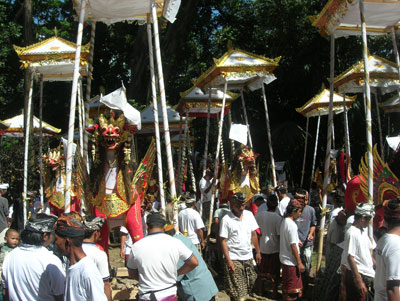Bali and beyond
by Donna DeGaetani, Los Angeles, CA
It was with much anticipation that I looked forward to the “Bali and Beyond” tour offered by Asia Transpacific Journeys (Boulder, CO; 800/642-2742, www.asiatranspacific.com) in July ’08. The thought of viewing Komodo dragons and orangutans in the wild was foremost in my mind.
Having traveled on three previous trips to Asia with ATJ, albeit custom tours, I knew that their attention to detail, competency in third-world situations and high level of travel professionalism would not disappoint — and it did not. In fact, this was quite a wonderful trip and one I’d recommend to any adventure traveler who also appreciates comfort and luxury as part of the experience.
Schooner sailing
Our travel group of 13 members and the highly experienced tour guide David Rand bonded early on the Bidadari, a 3-masted schooner which was our home for the first leg of the trip. We sailed for four days through Komodo National Park, which includes the islands of Komodo, Rinca and Padar, and spent time hiking and snorkeling the beautiful coral reefs.
For this, the first of four segments of the trip, we sailed to several islands, hiking as we searched for and found Komodo dragons as well as Timor deer, wild pigs, white-crested cockatoos, water buffalos, megapodes (birds endemic to only a few Indonesian islands) and other wildlife.
All groups visiting the islands of Komodo and Rinca need a guide, and our guides were outstanding, knowledgeable and well versed in English.
Bali and beyond
Our second leg was to Bali, where our local guide, Putu (the traditional name of first-born Balinese), took us to a Hindu cremation — quite an amazing all-day ceremony and a serendipitous and colorful part of the itinerary.
While in Bali, we trekked through local villages, drove to the highlands through rice paddies and visited Hindu and Buddhist temples as well as art, weaving and woodcarving “factories.” One evening, by firelight, we enjoyed a private performance of a kecak “monkey dance” performed by men only, who enacted scenes from the epic Ramayana.
Most Balinese are Hindu, and a spiritual atmosphere is evident everywhere on the island — in each home, temple and public site.
Leaving Bali, we flew to Java and then Borneo. Rimba Lodge, on the Sekonyer River in Kalimantan (the name for the Indonesian part of Borneo), provided basic accommodations but instantly launched us into the rainforest for experiences with wild orangutans and rehabilitated orangutans, both spectacular.
To our good fortune, Dr. Biruté Galdikas, the founder of Camp Leakey, a research and care center for orangutans, was there and we met orangutans that she had raised. At the feeding station, many visited her, including one named Princess who brought her baby to show Dr. Galdikas. It was quite touching and an amazing experience in human-animal connection.
Also amazing was the number of other males and females with babies who came to the feeding site from their independent lives in the forest to eat the rambutan and bananas offered and to visit the “mother” who raised them as orphans after they were brought to the center.
Macaques and proboscis monkeys played in the trees as we sailed down the river to and from the rehabilitation center.
Java
The next part of our trip was in Java. On the way to our flight to Borneo we had stopped in Java to visit Borobudur, the world’s largest Buddhist monument. A UNESCO World Heritage Site, it was quite impressive.
Later we settled in Yogyakarta for two days, visiting the Sultan’s Palace; the Water Palace; Prambanan, the largest Hindu temple in Indonesia, and a batik factory. One evening we attended a dramatic presentation of the Ramayana done in full costume by skilled performers.
Accommodations and cuisine
Throughout our trip, each of the hotels in which we stayed was luxurious, including The Oberoi, Kamandalu Resort & Spa and Elysian Bali Villas, all in Bali. Dusun Jogja Village Inn in Java was top of the line.
The Bidadari schooner offered accommodations with facilities en suite plus meals, and we were the only guests on board.
In Borneo, Rimba Lodge, while basic, had air-conditioning and was the best-available accommodation on the Sekonyer River.
I had looked forward to trying Indonesian cuisine, expecting a blend of spicy Southeast Asian, Portuguese and Dutch influences. At restaurants where meals were ordered individually, the food was quite good. However, this was not the case at the tourist-oriented lunch and dinner buffets, which were disappointing repeats of the same dishes: rice, noodles, fried chicken and fried fish. Hotel breakfast buffets, however, were great, with choices of Asian and American fare.
Summing up
We experienced friendliness and interest from the Indonesian people, on-time and competent service from the domestic airlines and an overall willingness to manage the different needs of Western travelers. While warm, the weather was never beyond the mid-80s (F). In the eastern islands, it was quite dry, while in Bali, Borneo and Java it was more humid.
The land-only tour cost was $6,295 per person, inclusive of most meals, site fees and local tipping (except for the main tour guide). International and domestic Indonesian flights cost extra.
In May ’08 the US lifted its warning for travelers visiting Indonesia, which will undoubtedly result in an increase in visitors.




